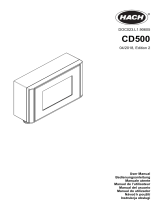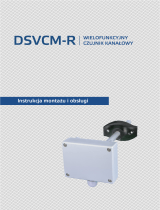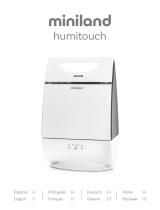
PRZETWORNIK
TEMPERATURY I WILGOTNOŚCI
TEMPERATURE
AND HUMIDITY TRANSDUCER
P18S
P18S
INSTRUKCJA OBSŁUGI - SZYBKI START
Pełna wersja instrukcji dostępna na
Full version of user’s manual available at
www.lumel.com.pl
USER’S MANUAL - QUICK START
PL
EN
Zeskanuj mnie
Zeskanuj kod Scan the code

2
2
PL
1. WYMAGANIA PODSTAWOWE,
BEZPIECZEŃSTWO UŻYTKOWANIA
W zakresie bezpieczeństwa użytkowania przetwornik odpo-
wiada wymaganiom normy PN-EN 61010-1.
2. MONTAŻ
2.1. Sposób mocowania
Przetwornik należy montować w sposób pewny i dający dostęp do ewentu-
alnej obsługi serwisowej (np. czyszczenie w przypadku zabrudzenia wpły-
wającego na pracę urządzenia, wymiana w przypadku uszkodzenia) przy
wykorzystaniu ogólnodostępnych elementów montażowych, takich jak np.
przepusty i dławiki kablowe, obejmy, opaski zaciskowe. Istotne jest zapew-
nienie pozycji pracy przetwornika aby jego czujnik pomiarowy skierowany
był w dół. Połączenia elektryczne należy wykonać zgodnie ze schematem
podłączeń przetwornika.
Uwagi dotyczące bezpieczeństwa
• Montażu i instalacji połączeń elektrycznych powinna dokonać
osoba z uprawnieniami do montażu urządzeń elektrycznych.
• Przed włączeniem przetwornika należy sprawdzić poprawność
połączeń.
• Przetwornik jest przeznaczony do instalowania i używania
w przemysłowych elektromagnetycznych warunkach środowiskowych.
min. 50mm
R20
83
12
R20
12
83
min. 50mm
Rys.1. Wymiary przetwornika P18S

3
3
PL
2.2. Schematy podłączeń zewnętrznych
Patrz strona 10.
3. OBSŁUGA
Po podłączeniu przewodów i włączeniu zasilania przetwornik
jest gotowy do pracy z nastawami fabrycznymi. Praca przetwornika syg-
nalizowana jest poprzez krótkie, cykliczne zaświecenie żółtej diody LED
umieszczonej pod osłoną czujnika.
Przetwornik może być konfigurowany poprzez zapis rejestrów pro-
tokołu MODBUS RTU na interfejsie RS-485.
W przetworniku można ustawić następujące parametry:
− adres urządzenia dla protokołu MODBUS RTU
− prędkość komunikacji interfejsu RS-485
− tryb komunikacji interfejsu RS-485
− tryb uśredniania pomiarów
− kasowanie zapamiętanych wartości ekstremów pomiarów
− załączenie/wyłączenie wewnętrznego grzejnika
− ustawienie czasu wygrzewania wewnętrznym grzejnikiem w
trybie czasowym
− stała poprawka dla pomiaru temperatury
Poprzez dedykowane rejestry można również przywrócić parame-
try fabryczne przetwornika oraz wymusić zapis aktualnych parametrów
pracy do pamięci nieulotnej przetwornika.
UWAGA: W przypadku, gdy w przetworniku ustawione są nieznane pa-
rametry transmisji, można wymusić komunikację przetwornika na para-
metrach standardowych (9600, 8N1). W tym celu należy:
− wyłączyć zasilanie przetwornika
− zdjąć osłonę czujnika
− zewrzeć ze sobą punkty lutownicze zgodnie z ilustracją 2
− włączyć zasilanie przetwornika (żółta dioda LED zaświeci się
światłem ciągłym)
− usunąć zwarcie (żółta dioda LED gaśnie)

4
4
PL
Rys.2. Ustawienie fabrycznych parametrów komunikacyjnych
W tym momencie można się połączyć z przetwornikiem i skonfigurować
go zgodnie z własnymi wymaganiami, a następnie zapisać konfigurację
do pamięci nieulotnej.
Jeśli konfiguracja nie zostanie zapisana, po ponownym uruchomieniu
przetwornika aktywna będzie poprzednia konfiguracja i procedura
będzie musiała zostać powtórzona.
4. DANE TECHNICZNE
Parametry podstawowe:
- zakres pomiaru wilgotności względnej (RH): 0...95%, bez kondensacji
- błąd podstawowy przetwarzania wilgotności: ± 3% zakresu dla RH = 10...90%
± 5% w pozostałym zakresie
- histereza pomiaru wilgotności: ± 1% RH
- podstawowy zakres pomiaru temperatury (T): -20...60°C
- błąd podstawowy przetwarzania temperatury: ± 0,6% w zakresie 10...40
o
C
± 1,0% w pozostałym zakresie
- wielkości wyliczone: wilgotność bezwzględna (a) [g/m
3
]; temperatura
punktu rosy (Td) [
o
C]
Interfejs RS-485: protokół transmisji: MODBUS RTU; prędkość trans-
misji: 2400, 4800, 9600,19200,38400, 57600, 115200 bit/s; tryb: 8N2,
8E1, 8O1, 8N1; maksymalny czas odpowiedzi: 500 ms
Znamionowe warunki użytkowania:
- zasilanie: 9...28 V d.c.
- pobór mocy < 0,5 VA

5
5
PL
- temperatura otoczenia: - 20...23...60
o
C
- wilgotność względna powietrza < 95%
- czas wstępnego wygrzewania: 15 minut
- stopień ochrony zapewniany przez obudowę: IP 65
- masa : <0,1 kg
- wymiary: (86 12,5) mm
- pozycja pracy: czujnikiem w dół
Kompatybilność elektromagnetyczna:
- odporność na zakłócenia elektromagnetyczne wg PN-EN 61000-6-2
- emisja zakłóceń elektromagnetycznych wg PN-EN 61000-6-4
Wymagania bezpieczeństwa: wg normy PN-EN 61010-1
- kategoria instalacji: III
- stopień zanieczyszczenia: 2
- napięcie pracy względem ziemi: 50 V
- wysokość nad poziomem morza < 2000m
5. KOD WYKONAŃ
P18S XX XX X X
Sposób podłączenia:
Gniazdo – wtyk M8 …, przewód 2m (gotowy cord) 00
Przewód 2 m 02
Przewód 5 m 05
Przewód 10 m 10
Wykonanie:
standardowe 00
Wersja językowa:
polsko-angielska M
Próby odbiorcze:
bez dodatkowych wymagań 0
z atestami kontroli jakości 1
ze świadectwem wzorcowania* 2

EN
6
EN
6
1. BASIC REQUIREMENTS,
OPERATIONAL SAFETY
In terms of operational safety, the transducer meets the requi-
rements of EN 61010-1 standard.
2. ASSEMBLY
2.1. Installation
The transducer should be mounted in a safe manner using ge-
nerally available assembly elements, such as cable glands and cable grom-
mets, clamps, cable ties enabling access when service works are needed
(e.g. cleaning in the event of soiling affecting the device operation, replace-
ment in the case of damage). It is important to ensure the transducer wor-
king position so that its measuring sensor is directed downwards. Electrical
connections should be made in accordance with the transducer connection
diagram.
Safety instructions
• The assembly and the installation of the electrical connections may
be carried out only by a duly qualified electrician.
• Before turning the transducer on verify the connections.
• The transducer is intended for installation and use in industrial electro-
magnetic environments.
Fig.1. External dimensions of P18S
min. 50mm
R20
83
12
R20
12
83
min. 50mm

EN
7
EN
7
2.2. External connections diagram
See page 10.
3. OPERATION
After wiring and turning on the power supply, the transducer is
ready for operation with the factory settings. Operation of the transducer
is signaled by a short, repeatable illumination of the yellow LED located
under the sensor cover.
The transducer can be configured by recording MODBUS RTU pro-
tocol registers on the RS-485 interface.
The following parameters can be programmed in the transducer:
− device address for MODBUS RTU protocol
− RS-485 interface baud rate
− RS-485 interface communication mode
− measurements averaging mode
− erasing the saved values of extreme measurements
− switching on/off the internal heater
− setting the heating time with the internal heater in time mode
− fixed correction for temperature measurement
Through dedicated registers, it is also possible to restore the trans-
ducer factory parameters and force the recording of current operating
parameters into the non-volatile memory of the transducer.
CAUTION: In case when unknown transmission parameters are set
in the transducer, it is possible to force the transducer communication
according to the standard parameters (9600, 8N1). To do this:
− turn off the transducer power supply
− remove the sensor cover
− short together the soldering points in accordance with figure 2
− turn on the transducer power supply (the LED will be solid yellow)
− remove the short circuit (yellow LED goes out)

EN
8
EN
8
Fig.2. Setting the standard communication parameters
At this point, it is possible to connect to the transducer and configure it
according to user’s requirements and then save the configuration to the
non-volatile memory.
If the configuration is not saved, the previous configuration will be
active after restarting the transducer and the procedure will have to be
repeated.
4. TECHNICAL DATA
Basic parameters:
- range of relative humidity (RH) measurement: 0...95%, without condensation
- intrinsic error of humidity processing: ± 3%of the range for RH = 10...90%
± 5% in the remaining range
- hysteresis of humidity measurement: ± 1% RH
- basic range of temperature measurement (T): -20...60°C
- intrinsic error of temperature processing:
± 0,6% within the range 10...40
o
C
± 1.0% in the remaining range
- calculated quantities: absolute humidity (a) [g/m
3
]; dew point temperature (Td) [
o
C]
Interface RS-485: transmission protocol: MODBUS RTU; baud rate:
2400, 4800, 9600,19200,38400,57600, 115200 bit/s; mode: 8N2, 8E1,
8O1, 8N1
maximum time to commence the response: 500 ms
Nominal operating conditions:
- power supply: 9...28 V d.c.

9
PL
9
PL
- power consumption < 0.5 VA
- ambient temperature: - 20...23...60
o
C
- air relative humidity < 95%
- time of initial warm-up: 15 minutes
- degree of protection provided by housing: IP 65
- weight <0.1 kg
- dimensions: (86 12.5) mm
- operating position: with sensor at the bottom
Electromagnetic compatibility:
- immunity to electromagnetic interference acc. to EN 61000-6-2
- emission of electromagnetic disturbances acc. to EN 61000-6-4
Safety requirements according to EN 61010-1 standard
- installation category: III
- pollution degree: 2
- operating voltage relative to earth: 50 V
- altitude above sea level < 2000m
5. ORDERING CODE
P18S XX XX X X
Connection way:
socket-plug M8 …, 2 m wire (included) 00
wire 2 m 02
wire 5 m 05
wire 10 m 10
Version:
standard 00
Language:
polish-english M
Acceptance tests:
without extra quality requirements 0
with quality inspection certifi cate 1
with calibration certifi cate 2

PL EN
10
PL
EN
10
SCHEMATY PODŁĄCZEŃ
ELECTRICAL CONNECTIONS
Przetwornik posiada 4 żyłowy przewód nierozłączny o długości 2,5
lub 10 m lub gniazdo rozłączne M8 wraz z przewodem długości 2 m
(w zależności od kodu wykonań) służący do zasilania oraz podłączenia
interfejsu RS-485:
The transducer has a 4-wire non-detachable cord which is 2.5 or 10m
long or a detachable M8 socket with a 2-meter long wire (depending on
the version code) used for supplying and connecting the RS-485 interface:
Table 1: Transducer terminals
Przewód
nierozłączny
(barwa
przewodu)/
Non-deta-
chable cord
(color of the
cord)
Gniazdo M8
(numer wypro-
wadzenia)
M8 socket
(terminal number)
Kabel
z wtykiem M8
(barwa
przewodu)
Cable with M8
plug
(color of the
cord)
Funkcja/
Function
zielony /
green
3
niebieski /
blue
Dodatni przewód zasilający VCC
Positive power cord VCC
żółty /
yellow
1
brązowy /
brown
Ujemny przewód zasilający GND
Negative power cord GND
brązowy /
brown
4
czarny /
black
RS-485 sygnał “B”
RS-485 ‚B’ signal
biały /
white
2
biały /
white
RS-485 sygnał “A”
RS-485 ‚A’ signal
Tabela 1: Wyprowadzenia przetwornika

PL EN
11
PL
EN
11

P18S-07
P18S-09
60-006-00-00889
Informacja techniczna:
tel.: (68) 45 75 306, 45 75 180, 45 75 260
e-mail: [email protected]
Realizacja zamówień:
tel.: (68) 45 75 207, 45 75 209, 45 75 218, 45 75 341
fax.: (68) 32 55 650
LUMEL S.A.
ul. Sulechowska 1, 65-022 Zielona Góra, Poland
tel.: +48 68 45 75 100, fax +48 68 45 75 508
www.lumel.com.pl
Pracownia systemów automatyki:
tel.: (68) 45 75 228, 45 75 117
Wzorcowanie:
tel.: (68) 45 75 161
e-mail: [email protected]
Export department:
tel.: (+48 68) 45 75 139, 45 75 233, 45 75 321,
45 75 386, 45 75 353
fax.: (+48 68) 32 54 091
e-mail: expor[email protected]
Calibration & Attestation:
tel.: (68) 45 75 161
e-mail: [email protected]
-
 1
1
-
 2
2
-
 3
3
-
 4
4
-
 5
5
-
 6
6
-
 7
7
-
 8
8
-
 9
9
-
 10
10
-
 11
11
-
 12
12
w innych językach
- English: Lumel P18S
Powiązane dokumenty
Inne dokumenty
-
Beta 682/60 Instrukcja obsługi
-
Benning MM4 Instrukcja obsługi
-
 Hach CD500 Instrukcja obsługi
Hach CD500 Instrukcja obsługi
-
OJ Electronics ESF-35 Instrukcja obsługi
-
 Sentera Controls DSVCM-R instrukcja
Sentera Controls DSVCM-R instrukcja
-
Hyundai HUM 770 Instrukcja obsługi
-
Gallet Marignane Instrukcja obsługi
-
Hyundai HUM 282 Instrukcja obsługi
-
 Miniland humitouch Instrukcja obsługi
Miniland humitouch Instrukcja obsługi
-
Sierra 240i & 241i Foundation Fieldbus Instruction Manual Instrukcja obsługi















